
The Gansu mole is a species of mammal in the family Talpidae endemic to central China, where it occurs in Shaanxi, Gansu, Sichuan, and Qinghai. It is the only species in the genus Scapanulus.

Zosterophyllum was a genus of Silurian-Devonian vascular land plants with naked branching axes on which usually kidney-shaped sporangia were arranged in lateral positions. It is the type genus for the group known as zosterophylls, thought to be part of the lineage from which modern lycophytes evolved. More than 20 species have been described.
Demersatheca is a genus of extinct vascular plants of the Early Devonian. Fossils were first found in the Posongchong Formation of eastern Yunnan, China. The plant had smooth leafless stems at least 1 mm in diameter, but only regions which bore spore-forming organs or sporangia are well-known. Sporangia were borne in 'spikes' or strobili, at least 40 mm long; one had 32 sporangia. Sporangia were arranged in four rows, two sporangia being opposite to one another on the stem with the next two being at right angles. Each sporangium consisted of two 'valves' which opened at the top to release their spores. A particular feature of Demersatheca which distinguishes it from other zosterophylls is that the stalk-less sporangia were sunken into the stem of the spike, so that the outer valve was flush with the surface.
Armatimonadota is a phylum of gram-negative bacteria.
Streptomyces scopuliridis is a bacterium species from the genus of Streptomyces which has been isolated from woodland soil from Rainbow Bluff in Lynn in Alabama in the United States. Streptomyces scopuliridis produces bacteriocins, desotamides B, desotamides C, desotamides D, sesquiterpenoids and herbicidins.
Microbacterium populi is a Gram-positive, non-spore-formin and aerobic bacterium from the genus Microbacterium which has been isolated from the bark of Populus × euramericana.
Kibdelosporangium lantanae is a bacterium from the genus of Kibdelosporangium which has been isolated from soil from the plant Lantana camara in Xiamen in China.
Shewanella fodinae is a Gram-negative and motile bacterium from the genus of Shewanella which has been isolated from a coal mine in India.
Salisediminibacterium is a genus of Gram-positive bacteria from the family of Bacillaceae. The type species is Salisediminibacterium halotolerans.
Salsuginibacillus is a genus of bacteria from the family of Bacillaceae.
Echinicola rosea is a Gram-negative, rod-shaped, aerobic and halotolerant bacterium from the genus of Echinicola which has been isolated from water from the South China Sea.
Kurthia populi is a bacterium from the genus of Kurthia.
Tsuneonella aeria is a Gram-negative and strictly aerobic bacterium from the genus Tsuneonella which has been isolated from air from the Xiangshan Mountain.
Sinopyrophorus is a genus of bioluminescent hard-bodied clicking beetles in the superfamily Elateroidea, and is the sole member of the recently recognized family Sinopyrophoridae. The genus currently contains a single species, Sinopyrophorus schimmeli, which was described in 2019 from the subtropical evergreen broadleaf forests of western Yunnan, China.
Enteractinococcus coprophilus is a bacterium from the genus of Enteractinococcus which has been isolated from the faeces of the Panthera tigris amoyensis from the Yunnan Wild Animal Park in China.
Enteractinococcus helveticum is a Gram-positive bacterium from the genus Enteractinococcus which has been isolated from industrial wastewater.
Enteractinococcus lamae is a bacterium from the genus Enteractinococcus which has been isolated from animal faeces from an alpaca from the Yunnan Wild Animal Park in China.
Enteractinococcus viverrae is a bacterium from the genus of Enteractinococcus which has been isolated from animal faeces from a Large Indian civet from the Yunnan Wild Animal Park in China.
Marinicauda pacifica is a Gram-negative and aerobic bacterium from the genus of Marinicauda which has been isolated from deep seawater.
Lysinibacillus antri is a Gram-positive, rod-shaped, endospore-forming and motile bacterium from the genus of Lysinibacillus which has been isolade from soil from a karst cave in Xingyi county.

